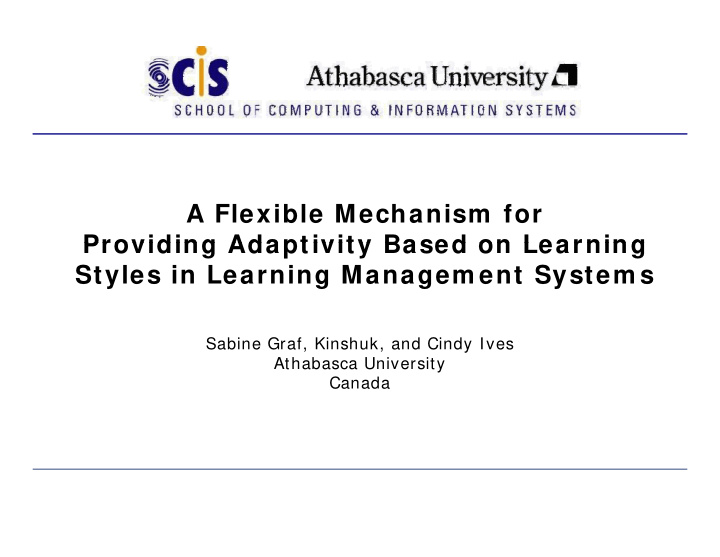



A Flexible Mechanism for Providing Adaptivity Based on Learning Providing Adaptivity Based on Learning Styles in Learning Managem ent System s Sabine Graf, Kinshuk, and Cindy Ives Athabasca University Canada Canada
Why learning styles? Why shall we consider learning styles in technology enhanced learning? technology enhanced learning? Complex and partially inconsistent field Learners have different ways in which they prefer Learners have different ways in which they prefer to learn If those preferences are not supported, learners p pp , can have difficulties in learning Previous studies showed that providing learners with course that fit their learning styles has with course that fit their learning styles has potential to help learners in learning 2
Felder-Silverman Learning Style Model Each learner has a preference on each of the dimensions Dimensions: Dimensions: Active – Reflective learning by doing – learning by thinking things through group work – work alone g p Sensing – Intuitive concrete material – abstract material more practical – more innovative and creative patient / not patient with details patient / not patient with details standard procedures – challenges Visual – Verbal learning from pictures – learning from words g p g Sequential – Global learn in linear steps – learn in large leaps good in using partial knowledge – need „big picture“ 3 3
Felder-Silverman Learning Style Model Scales of the dimensions: +11 +11 +9 +9 +7 +7 +5 +5 +3 +3 +1 +1 -1 1 -3 3 -5 5 -7 7 -9 9 -11 11 active reflective Strong Moderate Well balanced Moderate Strong preference preference preference preference Strong preference but no support problems Differences to other learning style models: describes learning style in more detail represents also balanced preferences represents also balanced preferences describes tendencies domain-independent flexible stable 4
Why learning management systems? Why shall we consider learning styles in learning management systems (LMSs)? learning management systems (LMSs)? LMSs are commonly used LMSs typically do not provide adaptivity for LMSs typically do not provide adaptivity for learners and deliver the same course for all learners 5
Aim of Research Extend LMSs so that they can automatically generate courses that fit students’ learning generate courses that fit students learning styles Make our approach applicable for LMSs in Make our approach applicable for LMSs in general Ask teachers for as little as possible additional Ask teachers for as little as possible additional effort 6
Previous Research Adaptive mechanism has been designed, implemented in Moodle and successfully implemented in Moodle and successfully evaluated with more than 500 students Adaptive mechanism was based on Adaptive mechanism was based on predefined course structure and 6 types of learning objects (Content, Outlines, g j ( Conclusions, Self-assessment tests, Examples, Exercises) Works well for courses with practical focus but does not work well for courses with theoretical focus theoretical focus 7
How to make the mechanism more flexible? Requirements Generic and work for different LMSs G i d k f diff LMS Require from teachers as little as possible additional work Restrict teachers as little as possible in their course design Restrict teachers as little as possible in their course design Solutions Use only types of LOs that are available in most LMSs Use only types of LOs that are available in most LMSs Only ask teachers to annotate LO with the type once they create them Use a course structure that allows many different types of LOs but does not require each type of LO to be available in each chapter/ section 8
Considered types of learning objects Commentaries Animations Content Objects Content Objects Exercises Exercises Reflection Quizzes Examples Self-Assessment Tests Real-Life Applications Discussion Forum Activities Conclusions Additional Reading Material Assignments Teachers can add many different types of LOs in their courses Teachers can add types of LOs whereever they feel they fit (as they usually do in LMSs) they usually do in LMSs) Teachers does not have to add types of LOs However, the more LOs are available in the course, the more adaptivity can be provided 9
How to provide adaptivity? Adaptive Annotation Distinguishing between recommended and standard learning objects Adaptive Sequencing Changing the sequence in which types of l learning objects are presented i bj t t d 10
Structure of a course Chapter 1 : Com m entary Few LOs that raise a student’s interest [ 0 ..2 types of LO] * Self-assessment tests, animations, exercises, examples, or real-life applications Content Content Conclusion [ 0 ..1 ] Rem aining LOs* S lf Self-assessment tests, animations, exercises, examples, t t t i ti i l real-life applications, additional reading material, reflection quizzes, and forum activities Conclusion [ 0 ..1 ] Conclusion [ 0 ..1 ] Assignm ents Chapter 2 : … * Sequence of LOs is based on how well the types of LO fit to the student’s 11 learning styles
12 Adaptivity in LMSs
13 Extensions of the LMS architecture
Conclusions & Future Work Introduced an adaptive mechanism that enables LMSs to automatically generate courses that fit students’ learning y g g styles Aimed at asking teachers for as little as possible additional effort effort Aimed at restricting teachers as little as possible in their course design Future work Developing a tool that allows teachers to add additional types of LOs Automatic and dynamic student modelling Evaluation of our concept 14
Recommend
More recommend